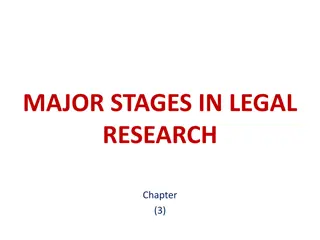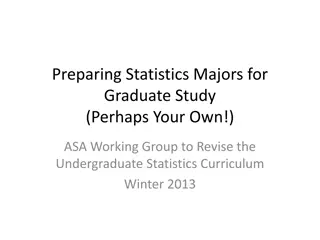Challenges in MMRM Analysis: Insights from Biostatistics Research
In this informative piece authored by Moses Mwangi from KEMRI, the limitations and challenges of Mixed Models Repeated Measures (MMRM) analysis are discussed. The content covers the introduction to MMRM, model formulation, motivating case studies, and concluding remarks. The article delves into the applications of MMRM in longitudinal studies, particularly in pharmaceutical trials, highlighting its benefits and drawbacks.
Download Presentation

Please find below an Image/Link to download the presentation.
The content on the website is provided AS IS for your information and personal use only. It may not be sold, licensed, or shared on other websites without obtaining consent from the author.If you encounter any issues during the download, it is possible that the publisher has removed the file from their server.
You are allowed to download the files provided on this website for personal or commercial use, subject to the condition that they are used lawfully. All files are the property of their respective owners.
The content on the website is provided AS IS for your information and personal use only. It may not be sold, licensed, or shared on other websites without obtaining consent from the author.
E N D
Presentation Transcript
Limitations and Challenges of Mixed Models Repeated Measures (MMRM) Analysis Moses Mwangi Kenya Medical Research Institute (KEMRI) Centre for Public Health Research (CPHR) Biostatistics and Bioinformatics unit Limitations and Challenges of MMRM Analysis 1
Overview Limitations and Challenges of MMRM Introduction to MMRM Model Formulation Motivating Case Study Concluding Remarks Limitations and Challenges of MMRM Analysis 2
Introduction to MMRM Introduction to MMRM Repeated Measures refer to multiple measurements taken from the same unit or subject (within experimental designs or observational studies) - each unit or subject measured repeatedly over time, space or both. Longitudinal data - special case of repeated measures - duration typically a variable of interest. MMRM - popular choice for randomized trials with longitudinal continuous outcomes. Suited to model continuous outcomes - repeatedly measured at discrete time points (or within defined time-windows). Limitations and Challenges of MMRM Analysis 3
Introduction to MMRM contd MMRM is widely covered in statistical literature on randomized trials, particular pharmaceutical industry trials. In this context patients are intended to be measured at each of a fixed number of measurement times. These time points are typically visits according to a schedule that is pre-defined in the trial protocol. In dose-response studies, MMRM can be applied for highly variable repeated measure data and is a way to estimate the drug effect at each visit and dose without any assumptions regarding the dose-response shape. Limitations and Challenges of MMRM Analysis 4
Introduction to MMRM contd MMRM is a specific model for balanced longitudinal data. For the fixed effects , one typically specifies effects of time (as a categorical or factor variable), randomized treatment group, and their interaction. This implies a saturated model for the mean - a separate mean parameter for each time point in each treatment group. Additionally, one can adjust for baseline covariates as simple main effects, or additionally with an interaction with time. Limitations and Challenges of MMRM Analysis 5
Motivating Case Study 2 Treatment x 2 Period Cross-over trial Outcome: Diastolic blood pressure (DBP) Treatment: 0=High-dose iodine salt; 1=Low-dose Iodine salt Period: 0=Period 1 (wk0-wk3); 1=Period 2 (wk4-wk6) Period 1 Period 2 wk5 wk6 Low-dose iodine High-dose iodine Sequence Subjects 1 2 wk0 wk1 wk2 wk3 wk4 High-dose iodine Low-dose Iodine 85 89 No washout period: contrary to standard cross-over design studies, was informed by ethical issues. unethical denying participants iodized household salts. Limitations and Challenges of MMRM Analysis 6
General Model Framework Laird and Ware (1982) introduced the basic linear mixed-effects (LME) model for a single ??-dimensional response (column) vector ??for the ? th subject as: ??= ??? + ????+ ??; ? = 1, ,? ; ?? ? (0, ?) ; ?? ? (0,?2???) Where; ??is the ?? ? 1 dimensional vector of observed responses for the ? th individual, ? is the p-dimensional vector of fixed-effects, ??is the q-dimensional vector of random subject-specific effects, ?? (of size ?? ? ?) and ?? (of size ?? ? ?) are known covariates matrices associated with observations to the fixed-effects and random-effects, respectively, and ??is the , ??-dimensional within-subject error. Limitations and Challenges of MMRM Analysis 7
Formulation for MMRM MMRM - an extension from a basic LME model to incorporate within-subject errors with unequal variances and/ or are correlated. For this purpose, we can express the within-subject errors as: ?? ? (0,??) ; ? = 1, ,? The within-group errors ??assumed to be independent for different ? and independent of the random effects ??. The variance-covariance matrix of the response vector ?? Y Var ) ( = + T i Z GZ R i i i Comprises a random-effects component ??. In longitudinal studies with only one level of grouping, the within-subject component is particularly important to be considered in order to account for within-subject correlation, whereas an additional random-effects component is often not strictly needed. Limitations and Challenges of MMRM Analysis and a within-subject component T i Z iGZ 8
Formulation for MMRM contd In clinical trial setting, one often chooses to directly model the variance-covariance structure of the response (to account for within-subject dependency) using the within- subject component ??, and can omit the random effects component ????. The variance-covariance matrix of the response vector ?? = ( ) Var Y R i i This yields the MMRM ??= ??? + ?? ?? ? (0,??) The linear predictor ??? typically considers fixed-effects of baseline values, treatment and visit, as well as interactions between treatment and visit, and possibly between baseline and visit. Commonly the fixed effects are of most interest and the correlation structure ??can be viewed as a nuisance quantity. However, it is important to model it carefully, since it affects validity of the estimated variance of ?. Limitations and Challenges of MMRM Analysis 9
Modeling cross-over data - MMRM Algebraic notation for the three candidate models: Grizzles Mixed-effects (GME) model: ???= 0+ 1??+ 2??+ 3??? + ?? Jones & Kenward Mixed-effects (JKME) model: ???= 0+ 1??+ 2??+ 3????+ 4???+ 5????? + ?? Piecewise Linear Mixed-effects (PLME) model: ???= 0+ 1??+ 2??+ 3????+ 4???+ 5?????+ 6?????+ 7??????? + ?? The PLME model does not assume fixed (constant) treatment effect across periods, hence more flexible in modeling curvilinear trends (in different periodic phases), without putting constrain on the curve evolution. Limitations and Challenges of MMRM Analysis 10
Modeling cross-over data - MMRM contd MMRM JKME SAS code PROC MIXED data = bloodpressure; CLASS PNO Period treatment time2; MODEL dbp = time2 treatment Period treatment*time2 Period*time2/ DDFM=KR; REPEATED treatment*time2/ SUBJECT = PNO TYPE = UN; /*7x7 - Correlated residuals between period 1 and 2; first 4 rows rep period 1 at the 4 time points; last 3 rows rep period 2 over the 3 time points*/ REPEATED time/ SUBJECT = PNO*treatment TYPE = UN; /*4x4 - Uncorrelated residuals between period 1 and 2*/ LSMEANS treatment*time2/ cl alpha = 0.05 diff e; ODS OUTPUT lsmeans = lsmeans diffs=diffs; RUN; Limitations and Challenges of MMRM Analysis 11
Modeling cross-over data - MMRM contd MMRM PLME SAS code PROC MIXED data = bloodpressure; CLASS PNO treatment time2 timespl1; MODEL dbp = time2 timespl1 treatment treatment*time2 treatment*timespl1/ DDFM=KR; REPEATED treatment*time2*timespl1/ SUBJECT = PNO TYPE = UN; /*7x7 - Correlated residuals between period 1 and 2; first 4 rows rep period 1 at the 4 time points; last 3 rows rep period 2 over the 3 time points*/ REPEATED time*timespl1/ SUBJECT = PNO*treatment TYPE = UN; /*4x4 - Uncorrelated residuals between period 1 and 2*/ LSMEANS treatment*time2 treatment*timespl1/ cl alpha = 0.05 diff e; ODS OUTPUT lsmeans = lsmeans diffs=diffs; RUN; Limitations and Challenges of MMRM Analysis 12
Limitations and Challenges of MMRM It generally only makes sense to fit the MMRM if subjects are measured at a common set of times, typical of designed studies (randomized trials in particular). If the measurements occur on a more ad-hoc basis, such that the times of measurement vary across subjects, it may no longer be feasible to treat time as a categorical variable.MMRM model can t really be fitted. With highly unbalanced designs, occasioned by intermittent missingness and dropouts, MMRM may encounter considerable challenges associated with cross-level bias (Sheppard 2003). Even with balanced RCT designs, the choice of treating time as a factor or a continuous variable depends on the research goal. If one prefers to see at what time-point the change was significant, across particular time- points, treating time as a categorical variable would be recommended. However, if one is interested in studying the functional relationship between the outcome and time, it is appropriate to treat time as a continuous variable, hence not feasible with MMRM. Limitations and Challenges of MMRM Analysis 13
Remarks - MMRM 1. Typically, MMRM specifies no patient level random effects, but instead models the correlation within the repeated measures over time by specifying that the residual errors are correlated. 2. Which means, subject-specific random effects (which are not of direct interest for estimation and inference) are considered as residual effects, i.e. they are part of the error correlation matrix. 3. To account for the correlation in measurements from the same patient, the MMRM specifies an unstructured covariance matrix for the residual errors. 4. The unstructured covariance matrix of residual errors reduces chances of model misspecification. 5. Only suitable in experimental designs Limitations and Challenges of MMRM Analysis 14
Modeling cross-over data - LME LME models consider both fixed and random effects and thus allow considerable modeling flexibility. However, it restricts within-group errors to be independent, identically distributed random variables with mean of zero and constant variance. In the case of clinical trials with repeated measurements of subjects over time, observations are not independent and within-subject correlation needs to be accounted for by the model. Limitations and Challenges of MMRM Analysis 15
Modeling cross-over data - LME contd Algebraic notation for the three candidate models: Grizzles Mixed-effects (GME) model: ???= 0+ 1??+ 2??+ 3??? +??0+ b?1??+ ?? Jones & Kenward Mixed-effects (JKME) model: ???= 0+ 1??+ 2??+ 3????+ 4???+ 5????? +??0+ b?1??+ ?? Piecewise Linear Mixed-effects (PLME) model: ???= 0+ 1??+ 2??+ 3????+ 4???+ 5?????+ 6?????+ 7??????? +??0+ b?1??(1 ??) + b?2??+ ?? The PLME model does not assume fixed (constant) treatment effect across periods, hence more flexible in modeling curvilinear trends (in different periodic phases), without putting constrain on the curve evolution. Limitations and Challenges of MMRM Analysis 16
Modeling cross-over data - LME contd MMRM JKME SAS code PROC MIXED data = bloodpressure; CLASS PNO Period treatment; MODEL dbp = time2 treatment Period treatment*time2 Period*time2/ DDFM=KR; RANDOM intercept time2/ SUBJECT = PNO TYPE = UN; /*7x7 - Correlated residuals between period 1 and 2; first 4 rows rep period 1 at the 4 time points; last 3 rows rep period 2 over the 3 time points*/ LSMEANS treatment/pdiff CL; ODS OUTPUT lsmeans = lsmeans pdiff=pdiff; RUN; Limitations and Challenges of MMRM Analysis 17
Modeling cross-over data - LME contd MMRM PLME SAS code PROC MIXED data = bloodpressure; CLASS PNO treatment; MODEL dbp = time2 timespl1 treatment treatment*time2 treatment*timespl1/ DDFM=KR; RANDOM intercept ime2 timespl1/ SUBJECT = PNO TYPE = UN; /*7x7 - Correlated residuals between period 1 and 2; first 4 rows rep period 1 at the 4 time points; last 3 rows rep period 2 over the 3 time points*/ LSMEANS treatment/pdiff CL; ODS OUTPUT lsmeans = lsmeans pdiff=pdiff; RUN; Limitations and Challenges of MMRM Analysis 18
RESULTS Figure 1: Spaghetti plot for DBP individuals profile Limitations and Challenges of MMRM Analysis 19
RESULTS contd Table 1: Model for continuous DBP with fixed- and random-effects GME model JKME model PLMEmodel Label Fixed effects Intercept: L Intercept: H Intercept: H - L Slope(time) before week 3: L Slope(time) before week 3: H Slope(time) before week 3: H - L Slope(time) after week 3: H Slope(time) after week 3: L Slope(time) after week 3: L - H Slope(time) change: LtoH Slope(time) change: HtoL Carry-over: (HtoL) - (LtoH) Average effect of H on DBP: (-(HtoL) - (LtoH))/2 Random effects Intercept Intercept time Time Intercept timespl1 time timespl1 timespl1 Residual Parameter Estimate(s.e.) p value Estimate(s.e.) p value Estimate(s.e.) p value 0 74.96(0.58) 74.37(0.58) -0.60 (0.30) <0.0001 74.38(0.61) <0.0001 74.62(0.60) 0.0480 0.24 (0.47) -0.34 (0.23) -1.02(0.23) -0.68 (0.30) <0.0001 75.96 (0.77) <0.0001 77.19 (0.79) 0.6159 1.23 (0.98) 0.1484 -0.63 (0.26) <0.0001 -1.71 (0.26) 0.0225 -1.08 (0.37) -0.68 (0.30) -0.13 (0.29) 0.55 (0.48) -0.04 (0.45) 1.58 (0.44) 1.63 (0.64) -0.81 (0.64) <0.0001 <0.0001 0.2113 0.0139 <0.0001 0.0035 0.0248 0.6643 0.2462 0.9213 0.0004 0.0111 0.0111 0+ 4 4 1 1+ 5 5 1+ 3 1+ 3+ 5+ 7 5+ 7 3 3+ 7 7 44.55 (5.80) -1.06 (1.25) 0.88 (0.50) 44.56 (5.79) -1.00 (1.23) 0.80 (0.49) 48.78 (6.88) -2.14 (1.62) 1.83 (0.66) 0.04 (2.59) -2.22 (1.05) 3.73 (1.87) 21.02 (1.19) ?2?0 ?0 ?1 ?2?1 ?0 ?2 ?1 ?2 ?2?2 ?2 23.97(1.21) 23.79(1.20) Limitations and Challenges of MMRM Analysis 20
RESULTS contd Results from the Analysis of DBP data Figure 2: Predicted DBP individual and mean profiles by treatment The PLME model does not assume fixed (constant) treatment effect across periods, hence more flexible in modeling curvilinear trends (in different periodic phases), without putting constrain on the curve evolution. Limitations and Challenges of MMRM Analysis 21
RESULTS contd Table 2: Model Fit with time, treatment and period as fixed effects Covariance matrix G Side - LME R Side - MMRM G Side - LME R Side - MMRM G Side - LME R Side - MMRM GME model JKME model PLME model Model fit criteria -2logL( ) 7263.8 7165.0 7267.8 7237.0 7274.1 7350.8 7251.9 7127.6 7255.9 7199.6 7262.2 7313.3 7248.1 7084.9 7252.1 7294.9 7258.4 7626.6 AIC BIC Limitations and Challenges of MMRM Analysis 22
References Fitzmaurice, G. M., Laird, N. M., & Ware, J. H. (2012). Applied longitudinal analysis (Vol. 998). John Wiley & Sons. Grizzle, J. E. (1965). The two-period change-over design and its use in clinical trials. Biometrics, 467 480. Grizzle, J. E. (1974). Correction to grizzle (1965). Biometrics, 30 (4), 727. Jones, B., & Kenward, M. G. (2015). Design and analysis of cross-over trials, third edition. Chapman and Hall/CRC. Molenberghs, G., & Verbeke, G. (2005). Models for discrete longitudinal data. New York: Springer. Sheppard L. Insights on bias and information in group-level studies. Biostatistics. 2003;4(2):265-78. Verbeke, G., & Molenberghs, G. (2009). Linear mixed models for longitudinal data. Springer Science & Business Media. Verbeke, G., Molenberghs, G., & Rizopoulos, D. (2010). Random effects models for longitudinal data. In Longitudinal research with latent variables (pp. 37 96). Springer Limitations and Challenges of MMRM Analysis 23
Acknowledgement The Gov. of Kenyan - MoH The Gov. of Belgium - VLIR-UOS The Gov. of Canada - IDRC KEMRI UHasselt JKUAT UoN All staff involved in making the VLIR-UOS TEAM Project Kenya a success Empowered Through VLIR-UOS TEAM Project Kenya 24























